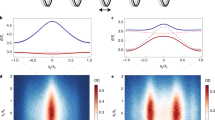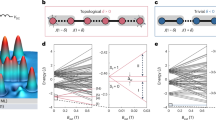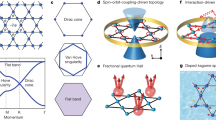Abstract
One of the intriguing properties of quantum many-body systems is the emergence of long-range order from particles with short-range interactions. For example, magnetism involves the long-range ordering of electron spins. Systems of ultracold atoms are rapidly emerging as precise and controllable simulators of magnetism and other phenomena. Spinor condensates1,2 are a powerful tool in this regard; however, the spin interaction is typically weak and accessible only when multiple atomic internal states are collisionally stable. Here we demonstrate a lattice-shaking technique for hybridizing Bloch bands in optical lattices to introduce a strong effective spin interaction and the formation of large ferromagnetic domains. Our band hybridization method is independent of the atomic internal state, and can be widely applied to quantum simulators to explore new magnetic phases in optical lattices with tunable band structure.
This is a preview of subscription content, access via your institution
Access options
Subscribe to this journal
Receive 12 print issues and online access
$259.00 per year
only $21.58 per issue
Buy this article
- Purchase on SpringerLink
- Instant access to full article PDF
Prices may be subject to local taxes which are calculated during checkout




Similar content being viewed by others
References
Stenger, J. et al. Spin domains in ground-state Bose–Einstein condensates. Nature 396, 345–348 (1998).
Sadler, L. E., Higbie, J. M., Leslie, S. R., Vengalattore, M. & Stamper-Kurn, D. M. Spontaneous symmetry breaking in a quenched ferromagnetic spinor Bose–Einstein condensate. Nature 443, 312–315 (2006).
Schmaljohann, H. et al. Dynamics of F = 2 spinor Bose–Einstein condensates. Phys. Rev. Lett. 92, 040402 (2004).
Chang, M-S., Qin, Q., Zhang, W., You, L. & Chapman, M. S. Coherent spinor dynamics in a spin-1 Bose condensate. Nature Phys. 1, 111–116 (2005).
Stamper-Kurn, D. M. & Ueda, M. Spinor Bose gases: Symmetries, magnetism, and quantum dynamics. Rev. Mod. Phys. 85, 1191–1244 (2013).
Vengalattore, M., Leslie, S. R., Guzman, J. & Stamper-Kurn, D. M. Spontaneously modulated spin textures in a dipolar spinor Bose–Einstein condensate. Phys. Rev. Lett. 100, 170403 (2008).
Kronjäger, J., Becker, C., Soltan-Panahi, P., Bongs, K. & Sengstock, K. Spontaneous pattern formation in an antiferromagnetic quantum gas. Phys. Rev. Lett. 105, 090402 (2010).
Vinit, A., Bookjans, E. M., de Melo, C. A. R. S. & Raman, C. Antiferromagnetic spatial ordering in a quenched one-dimensional spinor gas. Phys. Rev. Lett. 110, 165301 (2013).
Ho, T-L. Spinor Bose condensates in optical traps. Phys. Rev. Lett. 81, 742–745 (1998).
Ohmi, T. & Machida, K. Bose–Einstein condensation with internal degrees of freedom in alkali atom gases. J. Phys. Soc. Jpn 67, 1822–1825 (1998).
Guzman, J. et al. Long-time-scale dynamics of spin textures in a degenerate F = 187Rb spinor Bose gas. Phys. Rev. A 84, 063625 (2011).
Baumann, K., Guerlin, C., Brennecke, F. & Esslinger, T. Dicke quantum phase transition with a superfluid gas in an optical cavity. Nature 464, 1301–1306 (2010).
Simon, J. et al. Quantum simulation of antiferromagnetic spin chains in an optical lattice. Nature 472, 307–312 (2011).
Soltan-Panahi, P. et al. Multi-component quantum gases in spin-dependent hexagonal lattices. Nature Phys. 7, 434–440 (2011).
Jo, G-B. et al. Ultracold atoms in a tunable optical kagome lattice. Phys. Rev. Lett. 108, 045305 (2012).
Wirth, G., Ölschläger, M. & Hemmerich, A. Evidence for orbital superfluidity in the p-band of a bipartite optical square lattice. Nature Phys. 7, 147–153 (2011).
Gemelke, N., Sarajlic, E., Bidel, Y., Hong, S. & Chu, S. Parametric amplification of matter waves in periodically translated optical lattices. Phys. Rev. Lett. 95, 170404 (2005).
Lignier, H. et al. Dynamical control of matter-wave tunneling in periodic potentials. Phys. Rev. Lett. 99, 220403 (2007).
Struck, J. et al. Quantum simulation of frustrated classical magnetism in triangular optical lattices. Science 333, 996 (2011).
Struck, J. et al. Tunable gauge potential for neutral and spinless particles in driven optical lattices. Phys. Rev. Lett. 108, 225304 (2012).
Struck, J. et al. Engineering Ising-xy spin-models in a triangular lattice using tunable artificial gauge fields. Nature Phys. http://dx.doi.org/10.1038/nphys2750 (2013).
Lin, Y-J., Jiménez-Garcı´a, K. & Spielman, I. B. Spin-orbit-coupled Bose–Einstein condensates. Nature 471, 83–86 (2011).
Wang, C., Gao, C., Jian, C-M. & Zhai, H. Spin-orbit coupled spinor Bose–Einstein condensates. Phys. Rev. Lett. 105, 160403 (2010).
Ho, T-L. & Zhang, S. Bose–Einstein condensates with spin-orbit interaction. Phys. Rev. Lett. 107, 150403 (2011).
Dalton, B. J. & Ghanbari, S. Two mode theory of Bose–Einstein condensates: interferometry and the Josephson model. J. Mod. Opt. 59, 287–353 (2011).
Zhang, X., Hung, C-L., Tung, S-K. & Chin, C. Observation of quantum criticality with ultracold atoms in optical lattices. Science 335, 1070–1072 (2012).
Chin, C., Grimm, R., Julienne, P. & Tiesinga, E. Feshbach resonances in ultracold gases. Rev. Mod. Phys. 82, 1225–1286 (2010).
Shankar, R. Renormalization-group approach to interacting fermions. Rev. Mod. Phys. 66, 129–192 (1994).
Hung, C-L., Zhang, X., Gemelke, N. & Chin, C. Accelerating evaporative cooling of atoms into Bose–Einstein condensation in optical traps. Phys. Rev. A 78, 011604 (2008).
Acknowledgements
We thank C-K. Lin for assistance in the early stages of the experiment. We acknowledge useful discussions with N. Gemelke, I. Spielman, A. Rançon, H. Zhai and G. Baym. This work was supported by NSF MRSEC (DMR-0820054), NSF Grant No. PHY-0747907 and ARO Grant No. W911NF0710576 with funds from the DARPA OLE Program.
Author information
Authors and Affiliations
Contributions
L-C.H. performed the experiments. L-C.H. and C.V.P. analysed the data and C.V.P. wrote the manuscript. C.C. supervised.
Corresponding author
Ethics declarations
Competing interests
The authors declare no competing financial interests.
Supplementary information
Supplementary Information
Supplementary Information (PDF 580 kb)
Rights and permissions
About this article
Cite this article
Parker, C., Ha, LC. & Chin, C. Direct observation of effective ferromagnetic domains of cold atoms in a shaken optical lattice. Nature Phys 9, 769–774 (2013). https://doi.org/10.1038/nphys2789
Received:
Accepted:
Published:
Issue date:
DOI: https://doi.org/10.1038/nphys2789
This article is cited by
-
Observation of frustrated chiral dynamics in an interacting triangular flux ladder
Nature Communications (2023)
-
Domain-wall dynamics in Bose–Einstein condensates with synthetic gauge fields
Nature (2022)
-
Realizing discontinuous quantum phase transitions in a strongly correlated driven optical lattice
Nature Physics (2022)
-
Quantum gas magnifier for sub-lattice-resolved imaging of 3D quantum systems
Nature (2021)
-
Evidence for an atomic chiral superfluid with topological excitations
Nature (2021)



